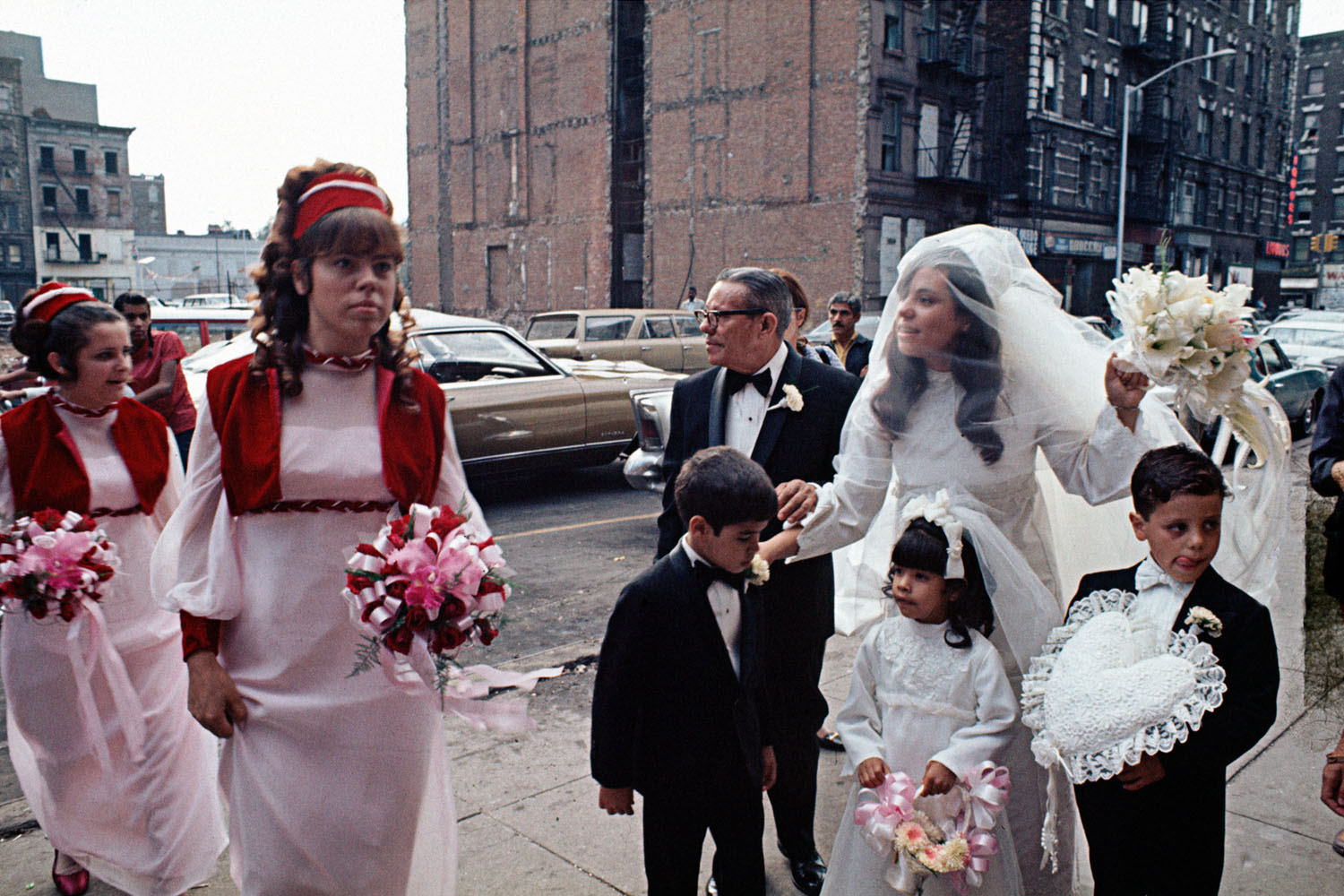
When I arrived in New York City in 1970, the Bronx was burning. I was photographing New York City during the Vietnam War before it barely escaped bankruptcy and before the Internet. Once-imposing and elegant buildings were derelict; the streets were dirty; parks were semi-abandoned and decrepit-looking schools evoked a culture different and separate from mainstream America. Abandoned buildings decayed. packs of dogs moved in and trees spontaneously took root and grew on their roofs. Squatters forced open doors and made holes in the walls. They removed boards from the windows to allow for light and ventilation, transforming empty buildings into homes for the homeless, places to sell drugs or serve as “shooting galleries.” The diamond-topped clock at Bloom Jeweler on Westchester Avenue in the Bronx had stopped at 6:20.
I was attracted to ghetto neighborhoods because they were gritty, tough, militant places, as evidenced in the large murals painted on the side of burnt-out shells encouraging blacks and Latinos to break the chains of oppression, to be born again, to be free. These were decaying, depopulated, dangerous, mysterious and exciting neighborhoods. The vibrant street life, the rebellious spirit, the absence of white people, the scenes of destruction all around me and the constant fear of being mugged made my visits unpredictable and memorable. In the streets I encountered a level of suspicion, anger and confusion matching my own. People didn’t know where the next blow was coming from.
Sidewalks were an extension of people’s confined living spaces. Men stand against a wall, rolling dice. Churches keep their doors open for ventilation as they conduct Bible-study programs, choir practices and board meetings. Church members sat on the sidewalk in front of their houses of worship. In those days, adults smiled as you photographed their children, asking you to share the photos with them.

I became an eavesdropper and a voyeur because I believed that the spirit of the ghetto would reveal itself through random bits of overheard conversation. I situated myself near public phones, listening intently to what people said and writing it down. In one long conversation I heard a man describe how his girlfriend had thrown all his belongings out of the apartment window into the street below.
Since I admired the work of photographers Helen Levitt, Aaron Siskind, Henri Cartier-Bresson and Roy DeCarava, I was delighted to encounter street scenes similar to those captured by these masters: black children playing with white dolls, jumping on discarded mattresses, and opening fire hydrants to spray friends and passersby. I photographed people walking up and down the stairs to the subway, men playing dominoes, naïve commercial signs, torn and faded advertisements, and, of course, graffiti. Sometimes I joined family members photographing weddings as they spilled out onto the streets. I went inside tenement buildings to make portraits of elderly people sitting in the dark looking at the street.
I wanted to capture the intimate life of the ghetto with the most sensitive film — my choice was high speed Ektachrome. I carried several lenses with me: wide angle lenses to capture panoramas and a telephoto in order to better record scenes undetected. During my early documentation I neglected to record names of people and addresses of buildings. What was the point of recording such information when the masters of photography themselves seldom included it with their work? All Henri Cartier-Bresson did was label a photograph “Family, Mexico 1934.” Like them, I was simply trying to capture essences that transcended time, personal names and physical space.
Fear was part of my photographic ventures. I learned to walk fast and to cross the street to avoid groups of menacing youths loitering on the other side. Several times I was told to clear out of the neighborhood — otherwise my camera would be taken or broken. Once I was punched in the face. My glasses fell in front of an unlicensed “gypsy cab.” Face on the ground, I watched the cab run over them. On the rare occasion when I encountered a police car on these blocks, policemen usually suspected I was in search of drugs. After asking if I was lost, they advised me to leave, warning me that if I stayed I would be robbed.
In the early 1970s I witnessed the stabbing of a young black man from the Metro North commuter train platform at East 125th Street and Park Avenue. It was a sunny afternoon, and I never thought of photographing the event. The blood was shinning red on the bare chest of the victim. I remember the assailant carrying the knife, first running slowly away, looking back several times as if not wanting to break his link with his victim, then running faster until he disappeared around the corner onto Madison Avenue.
When I showed my photographs to gallery and museum curators they were disinterested. Among these is the photograph of a black man driving his horse-drawn carriage full of junk north toward Harlem, along what seems to be Park Avenue. Another photo shows an elderly woman sitting on the sidewalk — on the wall behind her is a painted mural of the skyscraper city. Another one taken from the elevated subway platform show a man reading about the Baltimore Orioles.
Eager to be tough, I rejected my beginning efforts as sentimental and unoriginal. In 2013, I am happy my earliest pictures of New York survived. I see these images as fading glimpses of a city that disappeared — unique historical artifacts depicting intimate moments of people who stayed behind and documents of the decrepit buildings they inhabited.
Camilo José Vergara is a 2002 MacArthur fellow whose books include American Ruins and How the Other Half Worships. His newest book Harlem, the Unmaking of a Ghetto will be published by the University of Chicago Press in the fall. Vergara may be reached at camilojosev@gmail.com.
LightBox has previously featured Vergara’s work on urban murals depicting MLK as well as his photographs of the World Trade Center.
More Must-Reads From TIME
- The 100 Most Influential People of 2024
- The Revolution of Yulia Navalnaya
- 6 Compliments That Land Every Time
- What's the Deal With the Bitcoin Halving?
- If You're Dating Right Now , You're Brave: Column
- The AI That Could Heal a Divided Internet
- Fallout Is a Brilliant Model for the Future of Video Game Adaptations
- Want Weekly Recs on What to Watch, Read, and More? Sign Up for Worth Your Time
Contact us at letters@time.com